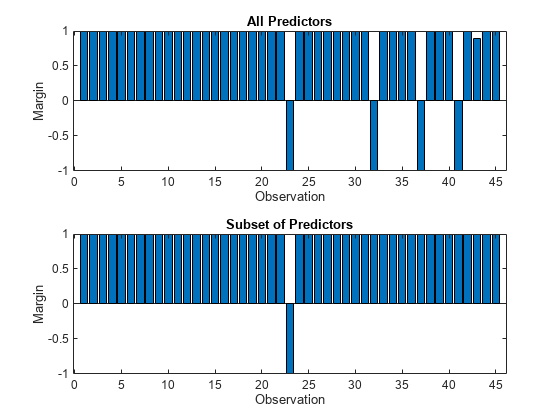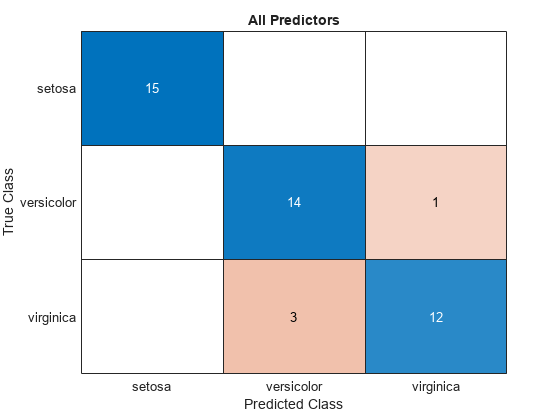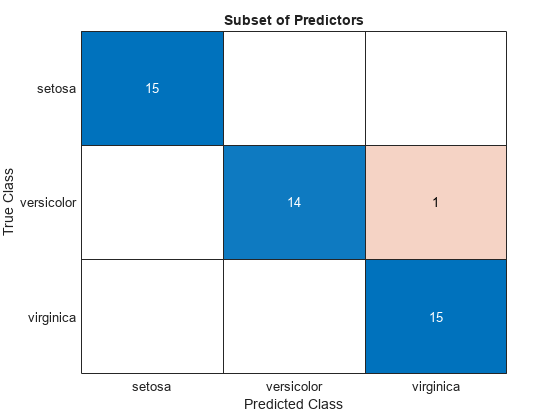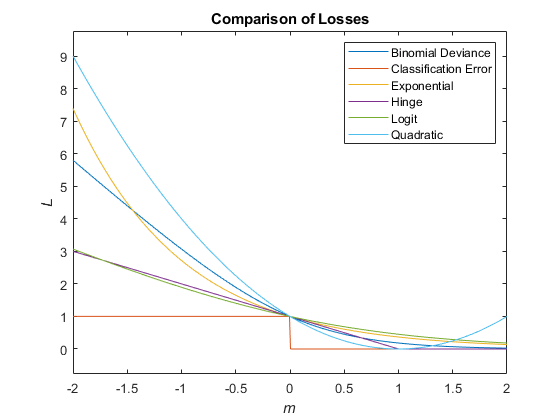loss
Description
L = loss(Mdl,Tbl,ResponseVarName)Mdl using the predictor
data in table Tbl and the class labels in the
ResponseVarName table variable.
L is returned as a scalar value that represents the
classification error by default.
L = loss(___,Name,Value)
Note
If the predictor data in X or Tbl contains
any missing values and LossFun is not set to
"classifcost", "classiferror", or
"mincost", the loss function can
return NaN. For more details, see loss can return NaN for predictor data with missing values.
Examples
Calculate the test set classification error of a neural network classifier.
Load the patients data set. Create a table from the data set. Each row corresponds to one patient, and each column corresponds to a diagnostic variable. Use the Smoker variable as the response variable, and the rest of the variables as predictors.
load patients
tbl = table(Diastolic,Systolic,Gender,Height,Weight,Age,Smoker);Separate the data into a training set tblTrain and a test set tblTest by using a stratified holdout partition. The software reserves approximately 30% of the observations for the test data set and uses the rest of the observations for the training data set.
rng("default") % For reproducibility of the partition c = cvpartition(tbl.Smoker,"Holdout",0.30); trainingIndices = training(c); testIndices = test(c); tblTrain = tbl(trainingIndices,:); tblTest = tbl(testIndices,:);
Train a neural network classifier using the training set. Specify the Smoker column of tblTrain as the response variable. Specify to standardize the numeric predictors.
Mdl = fitcnet(tblTrain,"Smoker", ... "Standardize",true);
Calculate the test set classification error. Classification error is the default loss type for neural network classifiers.
testError = loss(Mdl,tblTest,"Smoker")testError = 0.0671
testAccuracy = 1 - testError
testAccuracy = 0.9329
The neural network model correctly classifies approximately 93% of the test set observations.
Perform feature selection by comparing test set classification margins, edges, errors, and predictions. Compare the test set metrics for a model trained using all the predictors to the test set metrics for a model trained using only a subset of the predictors.
Load the sample file fisheriris.csv, which contains iris data including sepal length, sepal width, petal length, petal width, and species type. Read the file into a table.
fishertable = readtable('fisheriris.csv');Separate the data into a training set trainTbl and a test set testTbl by using a stratified holdout partition. The software reserves approximately 30% of the observations for the test data set and uses the rest of the observations for the training data set.
rng("default") c = cvpartition(fishertable.Species,"Holdout",0.3); trainTbl = fishertable(training(c),:); testTbl = fishertable(test(c),:);
Train one neural network classifier using all the predictors in the training set, and train another classifier using all the predictors except PetalWidth. For both models, specify Species as the response variable, and standardize the predictors.
allMdl = fitcnet(trainTbl,"Species","Standardize",true); subsetMdl = fitcnet(trainTbl,"Species ~ SepalLength + SepalWidth + PetalLength", ... "Standardize",true);
Calculate the test set classification margins for the two models. Because the test set includes only 45 observations, display the margins using bar graphs.
For each observation, the classification margin is the difference between the classification score for the true class and the maximal score for the false classes. Because neural network classifiers return classification scores that are posterior probabilities, margin values close to 1 indicate confident classifications and negative margin values indicate misclassifications.
tiledlayout(2,1) % Top axes ax1 = nexttile; allMargins = margin(allMdl,testTbl); bar(ax1,allMargins) xlabel(ax1,"Observation") ylabel(ax1,"Margin") title(ax1,"All Predictors") % Bottom axes ax2 = nexttile; subsetMargins = margin(subsetMdl,testTbl); bar(ax2,subsetMargins) xlabel(ax2,"Observation") ylabel(ax2,"Margin") title(ax2,"Subset of Predictors")

Compare the test set classification edge, or mean of the classification margins, of the two models.
allEdge = edge(allMdl,testTbl)
allEdge = 0.8198
subsetEdge = edge(subsetMdl,testTbl)
subsetEdge = 0.9556
Based on the test set classification margins and edges, the model trained on a subset of the predictors seems to outperform the model trained on all the predictors.
Compare the test set classification error of the two models.
allError = loss(allMdl,testTbl); allAccuracy = 1-allError
allAccuracy = 0.9111
subsetError = loss(subsetMdl,testTbl); subsetAccuracy = 1-subsetError
subsetAccuracy = 0.9778
Again, the model trained using only a subset of the predictors seems to perform better than the model trained using all the predictors.
Visualize the test set classification results using confusion matrices.
allLabels = predict(allMdl,testTbl);
figure
confusionchart(testTbl.Species,allLabels)
title("All Predictors")
subsetLabels = predict(subsetMdl,testTbl);
figure
confusionchart(testTbl.Species,subsetLabels)
title("Subset of Predictors")
The model trained using all the predictors misclassifies four of the test set observations. The model trained using a subset of the predictors misclassifies only one of the test set observations.
Given the test set performance of the two models, consider using the model trained using all the predictors except PetalWidth.
Input Arguments
Trained neural network classifier, specified as a ClassificationNeuralNetwork model object or CompactClassificationNeuralNetwork model object returned by fitcnet or
compact,
respectively.
Sample data, specified as a table. Each row of Tbl corresponds to one observation, and each column corresponds to one predictor variable. Optionally, Tbl can contain an additional column for the response variable. Tbl must contain all of the predictors used to train Mdl. Multicolumn variables and cell arrays other than cell arrays of character vectors are not allowed.
If
Tblcontains the response variable used to trainMdl, then you do not need to specifyResponseVarNameorY.If you trained
Mdlusing sample data contained in a table, then the input data forlossmust also be in a table.If you set
'Standardize',trueinfitcnetwhen trainingMdl, then the software standardizes the numeric columns of the predictor data using the corresponding means and standard deviations.
Data Types: table
Response variable name, specified as the name of a variable in Tbl. If Tbl contains the response variable used to train Mdl, then you do not need to specify ResponseVarName.
If you specify ResponseVarName, then you must specify it as a character
vector or string scalar. For example, if the response variable is stored as
Tbl.Y, then specify ResponseVarName as
'Y'. Otherwise, the software treats all columns of
Tbl, including Tbl.Y, as predictors.
The response variable must be a categorical, character, or string array; a logical or numeric vector; or a cell array of character vectors. If the response variable is a character array, then each element must correspond to one row of the array.
Data Types: char | string
Class labels, specified as a categorical, character, or string array; logical or numeric vector; or cell array of character vectors.
The data type of
Ymust be the same as the data type ofMdl.ClassNames. (The software treats string arrays as cell arrays of character vectors.)The distinct classes in
Ymust be a subset ofMdl.ClassNames.If
Yis a character array, then each element must correspond to one row of the array.The length of
Ymust be equal to the number of observations inXorTbl.
Data Types: categorical | char | string | logical | single | double | cell
Predictor data, specified as a numeric matrix. By default,
loss assumes that each row of X
corresponds to one observation, and each column corresponds to one predictor
variable.
Note
If you orient your predictor matrix so that observations correspond to columns and
specify 'ObservationsIn','columns', then you might experience a
significant reduction in computation time.
The length of Y and the number of observations in X must be equal.
If you set 'Standardize',true in fitcnet when training Mdl, then the software standardizes the numeric columns of the predictor data using the corresponding means and standard deviations.
Data Types: single | double
Name-Value Arguments
Specify optional pairs of arguments as
Name1=Value1,...,NameN=ValueN, where Name is
the argument name and Value is the corresponding value.
Name-value arguments must appear after other arguments, but the order of the
pairs does not matter.
Before R2021a, use commas to separate each name and value, and enclose
Name in quotes.
Example: loss(Mdl,Tbl,"Response","LossFun","crossentropy") specifies
to compute the cross-entropy loss for the model Mdl.
Loss function, specified as a built-in loss function name or a function handle.
This table lists the available loss functions. Specify one using its corresponding character vector or string scalar.
Value Description 'binodeviance'Binomial deviance 'classifcost'Observed misclassification cost 'classiferror'Misclassified rate in decimal 'crossentropy'Cross-entropy loss (for neural networks only) 'exponential'Exponential loss 'hinge'Hinge loss 'logit'Logistic loss 'mincost'Minimal expected misclassification cost (for classification scores that are posterior probabilities) 'quadratic'Quadratic loss For more details on loss functions, see Classification Loss.
To specify a custom loss function, use function handle notation. The function must have this form:
lossvalue =lossfun(C,S,W,Cost)The output argument
lossvalueis a scalar.You specify the function name (
lossfun).Cis ann-by-Klogical matrix with rows indicating the class to which the corresponding observation belongs.nis the number of observations inTblorX, andKis the number of distinct classes (numel(Mdl.ClassNames)). The column order corresponds to the class order inMdl.ClassNames. CreateCby settingC(p,q) = 1, if observationpis in classq, for each row. Set all other elements of rowpto0.Sis ann-by-Knumeric matrix of classification scores. The column order corresponds to the class order inMdl.ClassNames.Sis a matrix of classification scores, similar to the output ofpredict.Wis ann-by-1 numeric vector of observation weights.Costis aK-by-Knumeric matrix of misclassification costs. For example,Cost = ones(K) – eye(K)specifies a cost of0for correct classification and1for misclassification.
Example: 'LossFun','crossentropy'
Data Types: char | string | function_handle
Predictor data observation dimension, specified as 'rows' or
'columns'.
Note
If you orient your predictor matrix so that observations correspond to columns and
specify 'ObservationsIn','columns', then you might experience a
significant reduction in computation time. You cannot specify
'ObservationsIn','columns' for predictor data in a
table.
Data Types: char | string
Observation weights, specified as a nonnegative numeric vector or the name of a
variable in Tbl. The software weights each observation in
X or Tbl with the corresponding value in
Weights. The length of Weights must equal
the number of observations in X or
Tbl.
If you specify the input data as a table Tbl, then
Weights can be the name of a variable in
Tbl that contains a numeric vector. In this case, you must
specify Weights as a character vector or string scalar. For
example, if the weights vector W is stored as
Tbl.W, then specify it as 'W'.
By default, Weights is ones(n,1), where
n is the number of observations in X or
Tbl.
If you supply weights, then loss computes the weighted
classification loss and normalizes weights to sum to the value of the prior
probability in the respective class.
Data Types: single | double | char | string
More About
Classification loss functions measure the predictive inaccuracy of classification models. When you compare the same type of loss among many models, a lower loss indicates a better predictive model.
Consider the following scenario.
L is the weighted average classification loss.
n is the sample size.
For binary classification:
yj is the observed class label. The software codes it as –1 or 1, indicating the negative or positive class (or the first or second class in the
ClassNamesproperty), respectively.f(Xj) is the positive-class classification score for observation (row) j of the predictor data X.
mj = yjf(Xj) is the classification score for classifying observation j into the class corresponding to yj. Positive values of mj indicate correct classification and do not contribute much to the average loss. Negative values of mj indicate incorrect classification and contribute significantly to the average loss.
For algorithms that support multiclass classification (that is, K ≥ 3):
yj* is a vector of K – 1 zeros, with 1 in the position corresponding to the true, observed class yj. For example, if the true class of the second observation is the third class and K = 4, then y2* = [
0 0 1 0]′. The order of the classes corresponds to the order in theClassNamesproperty of the input model.f(Xj) is the length K vector of class scores for observation j of the predictor data X. The order of the scores corresponds to the order of the classes in the
ClassNamesproperty of the input model.mj = yj*′f(Xj). Therefore, mj is the scalar classification score that the model predicts for the true, observed class.
The weight for observation j is wj. The software normalizes the observation weights so that they sum to the corresponding prior class probability stored in the
Priorproperty. Therefore,
Given this scenario, the following table describes the supported loss functions that you can specify by using the LossFun name-value argument.
| Loss Function | Value of LossFun | Equation |
|---|---|---|
| Binomial deviance | "binodeviance" | |
| Observed misclassification cost | "classifcost" | where is the class label corresponding to the class with the maximal score, and is the user-specified cost of classifying an observation into class when its true class is yj. |
| Misclassified rate in decimal | "classiferror" | where I{·} is the indicator function. |
| Cross-entropy loss | "crossentropy" |
The weighted cross-entropy loss is where the weights are normalized to sum to n instead of 1. |
| Exponential loss | "exponential" | |
| Hinge loss | "hinge" | |
| Logistic loss | "logit" | |
| Minimal expected misclassification cost | "mincost" |
The software computes the weighted minimal expected classification cost using this procedure for observations j = 1,...,n.
The weighted average of the minimal expected misclassification cost loss is |
| Quadratic loss | "quadratic" |
If you use the default cost matrix (whose element value is 0 for correct classification
and 1 for incorrect classification), then the loss values for
"classifcost", "classiferror", and
"mincost" are identical. For a model with a nondefault cost matrix,
the "classifcost" loss is equivalent to the "mincost"
loss most of the time. These losses can be different if prediction into the class with
maximal posterior probability is different from prediction into the class with minimal
expected cost. Note that "mincost" is appropriate only if classification
scores are posterior probabilities.
This figure compares the loss functions (except "classifcost",
"crossentropy", and "mincost") over the score
m for one observation. Some functions are normalized to pass through
the point (0,1).

Extended Capabilities
This function fully supports GPU arrays. For more information, see Run MATLAB Functions on a GPU (Parallel Computing Toolbox).
Version History
Introduced in R2021aloss fully supports GPU arrays.
Starting in R2022a, the loss function uses the
"mincost" option (minimal expected misclassification cost) as the
default value for the LossFun name-value argument. The
"mincost" option is appropriate when classification scores are
posterior probabilities. In previous releases, the default value was
"classiferror".
You do not need to make any changes to your code for the default cost matrix (whose element value is 0 for correct classification and 1 for incorrect classification).
The loss function no longer omits an observation with a
NaN score when computing the weighted average classification loss. Therefore,
loss can now return NaN when the predictor data
X or the predictor variables in Tbl
contain any missing values, and the name-value argument LossFun is
not specified as "classifcost", "classiferror", or
"mincost". In most cases, if the test set observations do not
contain missing predictors, the loss function does not
return NaN.
This change improves the automatic selection of a classification model when you use
fitcauto.
Before this change, the software might select a model (expected to best classify new
data) with few non-NaN predictors.
If loss in your code returns NaN, you can update your code
to avoid this result by doing one of the following:
Remove or replace the missing values by using
rmmissingorfillmissing, respectively.Specify the name-value argument
LossFunas"classifcost","classiferror", or"mincost".
The following table shows the classification models for which the
loss object function might return NaN. For more details,
see the Compatibility Considerations for each loss
function.
| Model Type | Full or Compact Model Object | loss Object
Function |
|---|---|---|
| Discriminant analysis classification model | ClassificationDiscriminant, CompactClassificationDiscriminant | loss |
| Ensemble of learners for classification | ClassificationEnsemble, CompactClassificationEnsemble | loss |
| Gaussian kernel classification model | ClassificationKernel | loss |
| k-nearest neighbor classification model | ClassificationKNN | loss |
| Linear classification model | ClassificationLinear | loss |
| Neural network classification model | ClassificationNeuralNetwork, CompactClassificationNeuralNetwork | loss |
| Support vector machine (SVM) classification model | loss |
MATLAB Command
You clicked a link that corresponds to this MATLAB command:
Run the command by entering it in the MATLAB Command Window. Web browsers do not support MATLAB commands.
选择网站
选择网站以获取翻译的可用内容,以及查看当地活动和优惠。根据您的位置,我们建议您选择:。
您也可以从以下列表中选择网站:
如何获得最佳网站性能
选择中国网站(中文或英文)以获得最佳网站性能。其他 MathWorks 国家/地区网站并未针对您所在位置的访问进行优化。
美洲
- América Latina (Español)
- Canada (English)
- United States (English)
欧洲
- Belgium (English)
- Denmark (English)
- Deutschland (Deutsch)
- España (Español)
- Finland (English)
- France (Français)
- Ireland (English)
- Italia (Italiano)
- Luxembourg (English)
- Netherlands (English)
- Norway (English)
- Österreich (Deutsch)
- Portugal (English)
- Sweden (English)
- Switzerland
- United Kingdom (English)